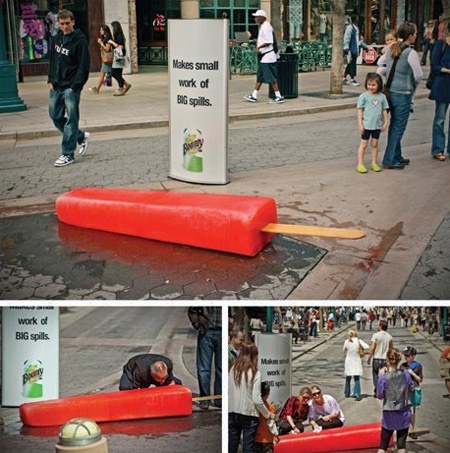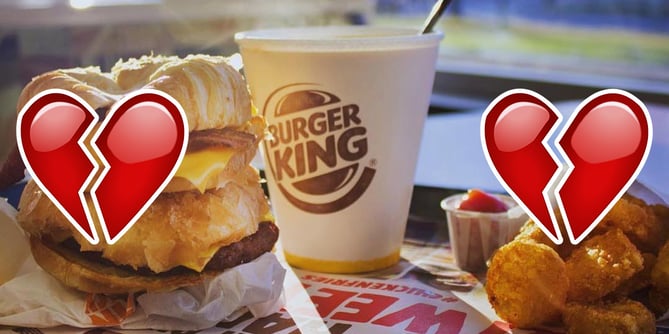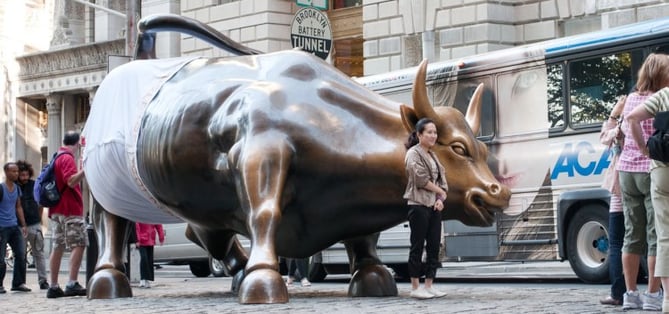Guerrilla Marketing Chapter 11 E Media Marketing Review
The word "guerrilla," in its written form, seems very intense. Information technology conjures images of rebellion and conflict. Put it next to the word "marketing," and it makes a lot of people ask, "Huh?" But guerrilla marketing isn't some sort of combative form of communication. In fact, it's actually a very unconventional form of marketing in that it raises brand sensation among large audiences without interrupting them. Guerilla marketing is a style to drive publicity and, every bit a result, brand awareness by promoting using anarchistic methods designed to evoke surprise, wonder, or shock. The term itself was created in the early 1980s by the late business writer Jay Conrad Levinson, who wrote several books about guerrilla tactics in a number of professional areas. Of course, at that time, marketing in general looked very different, and while guerrilla marketing is still used today, the ever-growing digital mural is changing what it looks like. When we hear the term "guerrilla marketing," it's hard non to recollect of guerrilla warfare -- which makes sense, since that's where this style of marketing got its name. In the warfare context, guerrilla tactics depend largely on the chemical element of surprise. Think: "Ambushes, sabotage, raids," according to Creative Guerrilla Marketing. Only how does that translate into the work we exercise every day? In marketing, guerrilla techniques mostly play on the element of surprise. It sets out to create highly unconventional campaigns that catch people unexpectedly in the course of their twenty-four hour period-to-twenty-four hours routines. What marketers really enjoy about guerrilla marketing is its adequately low-cost nature. The real investment here is a creative, intellectual one -- its implementation, however, doesn't have to exist expensive. Michael Brenner summarizes information technology nicely in his article on "guerrilla content," where he frames this style of marketing in the aforementioned context as repurposing your existing content, like taking certain segments of a study, and expanding each one into a blog mail. It's an investment of time, but non money, per se. In a way, guerrilla marketing works by repurposing your audition'southward electric current environment. Evaluate it and figure out which segments of it tin be repurposed to include your make. As niche as it might seem, in that location are really a few sub-categories of guerrilla marketing, as outlined past the firm ALT TERRAIN: Outdoor Guerrilla Marketing. Adds something to preexisting urban environments, like putting something removable onto a statue, or putting temporary artwork on sidewalks and streets. Indoor Guerilla Marketing. Similar to outdoor guerrilla marketing, merely it takes place in indoor locations like train stations, shops, and academy campus buildings. Event Ambush Guerilla Marketing. Leveraging the audition of an in-progress event -- like a concert or a sporting game -- to promote a production or service in a noticeable way, usually without permission from the consequence sponsors. Experiential Guerilla Marketing. All of the higher up, only executed in a way that requires the public to collaborate with the brand. Nosotros know -- without context, the whole idea of guerrilla marketing can be a little confusing, then let'south see how it'south been executed by a few other brands. Image Source By installing life-sized "messes" throughout the streets of New York -- a giant, knocked-over coffee cup and a gigantic melting popsicle -- Bounty found a unique mode to advertise its production and the solution it provides, with minimal words. You lot might inquire, "Wouldn't a curtailed billboard ad attain the same thing?" Well, not really. Culturally, we're starting to opt for every possible way to eradicate ads from our lives. That's why nosotros honey things like DVR and ad-free options on streaming services similar Hulu and YouTube. This entrada, unlike an ad, isn't as easy to ignore. After all, if you stumbled upon a melting popsicle the size of your mattress on your fashion to work, would y'all terminate and look? We would. The big takeaway: Place the biggest trouble that your product or service solves. Then, find an anarchistic manner to broadcast that to the public -- preferably without words. Epitome Source Some Tinder users were surprised to come across none other than comic anti-hero and fable Deadpool showing up on their Tinder. With "cheeky" pics and witty profile copy, Deadpool broke the fourth wall and met potential movie-goers ahead of the movie'due south Valentine's Day release. If the Tinder user "swiped correct" and matched with the character, they received a link to purchase tickets. While Tinder isn't the all-time style to generate buzz -- it's limited in its achieve to a small subset of users, and you lot're technically not allowed to employ the platform for promotion -- screenshots of this gag quickly made it to social media, garnering a ton of attention. The large takeaway: Promotions that apply "interruptive" techniques aren't frustrating if they create unexpected please. Accept you e'er seen how powerful of a motivator free food tin be? Brand it a sweet treat, and you have yourself a winning combination. Childish Gambino probable had this in listen for his "Summertime Starts Here" popular-upwardly events where gratuitous ice foam was given away. As people queued up in the rut for some delicious ice foam, Gambino'southward 2 singles played on a loud speaker. It was a great way to expose listeners to his EP, Summer Pack. The big takeaway: Sometimes you accept to draw an audition in with incentives to earn attention. Okay, this 1 might not be entirely fair, since it wasn't pulled off "in real life." Just how cool would information technology be if it was? To promote the nominees for its Album Of The Year category, the GRAMMYS music awards show created a video to show what would happen if posters for the nominated artists only began singing. Information technology might sound impossible to really comport out something similar that. But imagine -- what if you could create musical posters for your brand? Again, information technology'south dissimilar than a billboard ad because, when we walk by a wall of paper advertisements in, say, New York City, we don't wait them to start moving. Now, we'll admit that this idea isn't exactly a budget-friendly one, as it might require some technical work to bring to fruition. Simply even if you lot could include a unmarried moving or digital image amidst a ocean of still ones -- in a identify where information technology would come as a surprise, like a brick wall -- it would catch people off baby-sit and, therefore, get their attention. The big takeaway: Think almost the things that your audience might merely laissez passer by every day -- and brand those things practise something that's both unexpected and interactive. Image Source When I starting time saw this photo, I'll admit that I fell for it. "Someone, become that dog away from those flies!" I aimlessly thought. Then, I realized that the dog wasn't real, and neither were the flies. The former was a photo, and the latter were actually humans. That'south because Frontline, the makers of flea and tick prevention products for dogs, were able to fill the entire floor of this large, public space with this epitome. The make knew that many people walk across that space every day, and that a good number of people would also see information technology from the building'due south upper levels, creating the canis familiaris-and-insect illusion. It's hard to miss -- and to non look twice. Again, this entrada is different than traditional marketing considering it's not just plastering a single message somewhere that's likely to exist ignored. Information technology creates a class of accidental man interaction that reminds the viewer what the product does. The big takeaway: Figure out how humans might involuntarily collaborate with your marketing messages. While your product or service may not address the issue of, say, insect removal, there are means to brand people part of the campaign. Image Source Breaking upwards is hard to exercise in person, let alone when it's publicly played out online. That'southward what happened -- allegedly -- when one Instagram user left a annotate on one of Burger King'due south Instagram posts sharing a tale of his "girl" procuring food from Burger King. At that place was but one problem. This guy does take a girlfriend, but she was nowhere most a Burger King. So, who was he referring to? The drama ensued, via Instagram comments: Afterward the comments began to make headlines, many speculated that the entire exchange may take been staged by Burger King. And if it was, nosotros can't help merely salute them -- what a way to get your brand into the zeitgeist. Burger Rex has roughly one meg followers on Instagram. And while nosotros're not sure how many followers the former had before this famous breakup, information technology makes sense to assume that this at least drew more attention to its social media presence, at least on this particular platform. People may have already been observing the brand on Instagram, merely earlier now, were they actively discussing it? The big takeaway: Guerrilla marketing has gone digital. Call back about where your audience already exists digitally -- then, give 'em a show. While we can't condone lying, we can applaud creativity, and then don't exist afraid to employ the comments to get people talking. I'grand as guilty as anyone of wasting money on bottled h2o. I have no alibi. I have a reusable one. My workplace offers filtered water from a machine, not a traditional cooler, and yet, it remains a bad habit. That's why this guerrilla marketing campaign from relief organization UNICEF resonated with me. Information technology posed the question, "What if those bottles of h2o you waste money on were filled with muddied water?" It was a way of reminding the privileged masses that in too many parts of the world, unabridged populations accept no access to make clean drinking h2o. So instead of frivolously spending that coin on bottled water, UNICEF suggested putting it toward efforts to bring clean drinking water to these areas. Information technology did and so by creating makeshift vending machines that sold bottled muddied h2o, with each button labeled as a illness caused by a lack of make clean drinking water. The big takeaway: Guerrilla marketing works in the not-for-profit sector, likewise. And while scary, saddening images are oft an impactful fashion of communicating your mission, there's a style to convey information technology past creating something less in-your-face and interactive for the public. Prototype Source Are y'all an underwear company looking for an anarchistic way to market your product? Why, just try placing an enormous pair of briefs on an iconic charging bull statue. Really, we can't make this stuff upward. It's then simple, in theory, that it sounds similar fiction. Merely when the GoldToe brand needed a way to tease and promote the launch of its new undergarments, that's exactly what it did -- casually placed these new items of vesture on statues throughout New York. And while nosotros can't exist certain that it's the road GoldToe took, we sincerely hope that those bull-sized briefs were fabricated with leftover manufacturing textile, helping to make this campaign even budget-friendlier. The large takeaway: Don't overthink it. Sometimes what looks like your silliest idea might exist the all-time 1. How is this real? #FijiGirl #GoldenGlobes pic.twitter.com/Fko3XMmupa Strategic product placement is ane guerilla marketing tactic to gain attending in subtle ways. I such instance includes Republic of the fiji islands Water's presence at the 2019 Gilt Globes where models wore blue and carried trays of water for thirsty attendees. Information technology didn't end in that location, though. One model -- Kelleth Cuthbert -- positioned herself in the background during photoshoots, effectively photo-bombing high-profile celebrities. When the photos started appearing on social media, people began noticing Cuthbert as a common denominator, dubbing her #FijiGirl. Ultimately, she became one of the highlights of the evening, winning over fans and drawing attention to Fiji Water's brand. The big takeaway: Your make doesn't need to be the focus of an outcome for it to stand out. When pub and brewing company Greene King feared that pocket-size, neighborhood establishments -- notably, the pub -- would showtime to be overtaken past large corporate retail, information technology launched a entrada to communicate just how important these local businesses actually are. Even improve, the content was almost entirely created by those who understand this predicament best: Pub owners, bartenders, and patrons. These individuals were given cameras to capture video of the nigh meaningful moments and gatherings they've experienced inside these local pubs -- from weddings, to funeral receptions, to birthdays. These videos were shared on Greene King's YouTube profile and posed the question, "Without these neighborhood coming together places, where would we share these moments?" The big takeaway: It's okay to become a little sentimental with guerilla marketing. Recollect about the emotions invoked by what you offer. Then, invite your audience to create content around what your brand ways to them. Epitome Source When I recall of Count Dracula, I conjure the penultimate villain synonymous with everything that goes crash-land in the dark. The BBC wanted to capitalize on this feeling to promote their bear witness, Dracula. By twenty-four hour period, their billboard was designed to be minimalistic with red text on a white background with a few bloody stakes. However, like its subject, the billboard inverse completely every time nighttime brutal. The stakes were actually strategically placed -- to cast a shadow of Dracula himself. The installation ended upward being featured in Adweek and had some viral success for its creativity and expert implementation. The big takeaway: Recall outside the box for your advertising materials. In this case, light and shadow were enough to convey the message and capture attention. Starting to make a little more sense? Hopefully, you'll be inspired by these examples, peculiarly if you lot're promoting a smaller brand. Don't be afraid to crowdsource the content for these campaigns, for example -- after all, it's creative approaches to your work that help maintain guerrilla marketing's budget-friendly, inbound nature. Remember: Take hold of people where they are, and insert your make there. Don't interrupt, only invite them to participate. Editor's note: This mail was originally published in July 2018 and has been updated for comprehensiveness. 
What is guerilla marketing?
Roots of Warfare
Upkeep-Friendly
Types of Guerrilla Marketing
Guerrilla Marketing Examples to Inspire Your Make
i. Bounty'due south Behemothic Popsicle

2. Deadpool'south Tinder Profile

3. Kittenish Gambino's Ice Cream Pop-Up
four. The GRAMMYs Singing Posters
5. Frontline's Interactive Floor Ad

half dozen. Public Breakup on Burger King's Instagram


7. UNICEF's Dirty Water Vending Machines
8. GoldToe's Giant Briefs

nine. Fiji Water's #FijiGirl
10. Greene Rex's Candid Videos
eleven. BBC's Dracula Billboard

Guerrillas in the Wild


Originally published Aug 17, 2021 1:30:00 PM, updated August 17 2021
Source: https://blog.hubspot.com/marketing/guerilla-marketing-examples
0 Response to "Guerrilla Marketing Chapter 11 E Media Marketing Review"
Postar um comentário